
For example, consider the definitions and theorem below :
DEFINITION: An angle is a figure formed by two rays that have the same endpoint. The two rays are called the sides of the angle and the common endpoint is called the vertex.
DEFINITION: A pair of angles are said to be adjacent if the two angles have a common vertex, share a side, and do not have any interior points in common.
DEFINITION: A pair of angles are said to be vertical if they share the same vertex, are bounded by the same pair of lines, and are not adjacent.
Euclidean Geometry Theorem: Vertical angles are congruent.
These same definitions of angles, adjacent angles and vertical angles can be applied
to the points, lines and rays of hyperbolic geometry. It then is natural to ask:
Are all pairs of vertical angles congruent in hyperbolic geometry?
NonEuclid can be used to help gain an intuition about the answer to such questions. For example:
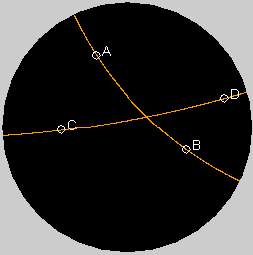 figure 3.01-A |
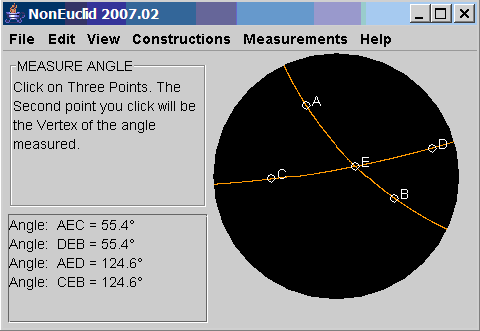 figure 3.01-B |
This type of exploration does, however, offer a chance to develop a more informed intuition about the geometry. Often this intuition can lead to a breakthrough in writing a formal proof. This intuition can also make it easier to understand other peoples proof. Besides, the moving, twisting lines that maintain defined relationships in the hyperbolic geometry model look cool.
What follows in this section is a list of definitions and Euclidean geometry theorems that can be applied to and explored in hyperbolic geometry. In each case, attempt to construct the figures that are defined. In some cases this will not be possible because not all objects defined in Euclidean geometry exist in hyperbolic geometry. For example, in hyperbolic geometry, it is impossible to construct a quadrilateral with 4 right angles. However, many of the objects defined in Euclidean geometry can be constructed in Hyperbolic geometry. Indeed, in many cases, the exact same straight-edge and compass procedure used in Euclidean geometry will work in hyperbolic geometry. If you come to believe that a particular figure cannot be constructed, then attempt to explain why.
After you have succeeded in constructing a figure, then search for counter-examples of Euclidean Geometry theorems about that figure, and enjoy.
Note on Definitions:
The definitions given in this section are not official. For example, some
high school geometry textbooks define a square as a rectangle where the adjacent
sides have equal length. Other textbooks define a square as a regular quadrilateral.
In Euclidean geometry, these two definitions are equivalent: whichever is
chosen as the definition, the other follows as a theorem. In hyperbolic geometry,
however, these two definitions are not equivalent: Rectangles (quadrilaterals with
four right angles) do not exist in hyperbolic geometry, yet regular quadrilaterals
do. Therefore, unlike the usual high school textbook, the definitions below have
been chosen while considering both geometries.
Activity 3.02-1: Use NonEuclid to construct a pair of intersecting lines. Use the "Plot Intersection Point" command to construct the intersection point of the two lines. Use the "Measure Angle" command to measure the four angles formed by the intersection. Use the "Move Point" command to move one of the lines until a pair of adjacent angles have the equal measure. If you succeed in doing this, then, by the definition above, the two angles are right angles and the two lines are perpendicular.
Activity 3.02-2: What is the angle measure of each of the right angles?
Right Angle Axiom:
The Right Angle Axiom is one of the fundintamal axioms or assumptions of
Euclidean geometry. It states:
If two lines cross such that a pair of adjacent angles are congruent,
then each of these angles is also congruent to any other angle formed
in the same way.
Activity 3.02-3: Does the Right Angle Axion hold in hyperbolic geometry? Test this impericaly by constructing crossing lines with congruent adjacent angles. Do such angles always have the same angle measure?
DEFINITION: A pair of angles are said to be supplementary if the sum of the measure of the two angles equals two right angles.
Straight Angle Theorem: Given a pair of intersecting lines. Any two adjacent angles formed by this intersection are supplementary.
Activity 3.02-4: Does the Straight Angle Theorem hold in hyperbolic geometry?
DEFINITION: Given a line segment AB, and a point C on AB, if the distance from A to C equals as the distance from C to The B, then C is said to be the midpoint of line segment AB.
DEFINITION: A segment bisector is any line that passes through the midpoint of a line segment. If a segment bisector is perpendicular to the segment, then the segment bisector is called a perpendicular bisector of the segment.
Perpendicular Bisector Construction:
DEFINITION: The bisector of an angle is a ray whose endpoint is the vertex of the angle, and which divides the angle into two adjacent angles each having the same measure.
Angle Bisector Construction:
DEFINITION: A median of a triangle is a line that passes through a vertex of the triangle and through the midpoint of the side opposite that vertex.
DEFINITION: An altitude of a triangle is a line through a vertex that is perpendicular to the line of which the side opposite that vertex is a segment.
DEFINITION: Three or more lines are said to be concurrent if they intersect at a single point.
Activity (3.03-1 through 3.03-8): Each of the statements below is a theorem about triangles in Euclidean geometry. Which, if any, are theorems in hyperbolic geometry? Construct an example or counter-example of each.
Activity 3.03-1: The sum of the angles of a triangle is 180 degrees.
Activity 3.03-2: The longest side of a triangle is opposite the greatest angle.
Activity 3.03-3:
The three altitudes of a triangle are concurrent.
Hint 1: To construct an altitude of a triangle, use the "Draw Perpendicular"
command from the "Constructions" menu. Click the mouse on any two
vertices to define the base. Then click on the third vertex to draw
the altitude. If you construct the three altitudes in this way, then you will
be able to use the "Move Point" command to move any of the triangle vertices,
and NonEuclid will automatically update the altitudes.
Hint 2: There is a tricky special case to be found here.
Explore until you find it.
Activity 3.03-4: The three medians of a triangle are concurrent.
Activity 3.03-5: The three angle bisectors of the three angles of a triangle are concurrent.
Activity 3.03-6: In a triangle, the sum of any two sides is always greater than the length of the third side.
Activity 3.03-7: In a triangle, if one of the sides is extended, the exterior angle is greater than either of the opposite interior angles.
Activity 3.03-8: In a triangle, the product "base times height" is the same regardless of which side is chosen as the base. For example, in triangle ABC, the length of side AB times the perpendicular distance from AB to C equals the length of AC times the perpendicular distance from AC to B.
DEFINITION: An
isosceles triangle is a triangle that has at least two sides of the
same length. The third side of an isosceles triangle is called the base.
Isosceles Triangle Construction:
Activity (3.03-10 through 3.03-12): Each of the statements below is a theorem about isosceles triangles in Euclidean geometry. Which, if any, are theorems in hyperbolic geometry? Construct an example or counter-example of each.
Activity 3.03-10: The base angles of an isosceles triangle are congruent.
Activity 3.03-11: The altitude of an isosceles triangle bisects its base.
Activity 3.03-12: The altitude of an isosceles triangle bisects the angle opposite the base.
DEFINITION: An equilateral triangle is a triangle whose three sides all have equal length.
DEFINITION: An equiangular triangle is a triangle whose three angles all have the same measure.
Activity 3.03-13: Use NonEuclid to construct an equilateral triangle such that the "Move Point" command can be used to change the size and location of the triangle while maintaining its property of being equilateral.
Activity (3.03-14 through 3.03-16): Each of the statements below is a theorem in Euclidean geometry. Which, if any, are theorems in hyperbolic geometry? Construct an example or counter-example of each.
Activity 3.03-14: If a triangle is equilateral, then it is equiangular.
Activity 3.03-15: If a triangle is equiangular, then it is equilateral.
Activity 3.03-16: Each angle of an equilateral triangle measures 60 degrees.
DEFINITION: A
right triangle is a triangle that has exactly one right angle. The side
opposite the right angle is called the hypotenuse, and the remaining sides
are called legs.
Pythagorean Theorem: In any right triangle, the length of the hypotenuse (c) times itself is equal to the length of one leg (a) times itself plus the length of the other leg (b) times itself (a2 + b2 = c2).
Activity 3.03-17: Does the Pythagorean theorem hold in hyperbolic geometry?
ACTIVITY 3.04-1: A good way to explore properties of congruent triangles is to use "Reflect" command from the "Constructions" menu:
Activity 3.04-2: Does SSS hold in hyperbolic geometry?
Side-Angle-Side Triangle Congruence Theorem (SAS): If two sides and an included angle of one triangle have the same lengths and measure as two sides and an included angle of a second triangle, then the two triangles are congruent.
Activity 3.04-3: Does SAS hold in hyperbolic geometry?
Activity 3.04-4: Does AAS hold in hyperbolic geometry?
Activity 3.04-5: Does ASA hold in hyperbolic geometry?
Activity 3.04-6: In Euclidean geometry, ASS is bad - that is it is not sufficient to prove a pair of triangles congruent. Is ASS sufficient to prove triangles congruent in hyperbolic geometry?
Activity 3.04-7: In Euclidean geometry, AAA, is not sufficient to prove a pair of triangles congruent. Is AAA sufficient to prove triangles congruent in hyperbolic geometry?
DEFINITION:
Given four points A, B, C, and D, such that they all lie in the
same plane, but no three are collinear. If the segments AB, BC, CD,
and DA intersect only at their end points, then their union is called a
quadrilateral.
DEFINITION: A
rhombus is a quadrilateral in which all four sides have equal length.
Activity 3.05-1: Use NonEuclid to construct a rhombus. Use construction rules such that the "Move Point" command can be used to move and resize the rhombus while maintaining it as a rhombus.
Activity (3.05-2 through 3.05-5): The following is a list of theorems about rhombi in Euclidean geometry. Which (if any) are theorems in hyperbolic geometry? Construct an example or counter-example of each.
Activity 3.05-2: The opposite angles of a rhombus are congruent.
Activity 3.05-3: The diagonals of a rhombus bisect each other.
Activity 3.05-4: The diagonals of a rhombus are perpendicular.
Activity 3.05-5: The diagonals of a rhombus bisect the rhombus's angles.
DEFINITION: A square is a rectangle with four sides of equal length.
DEFINITION: A regular quadrilateral is a quadrilateral in which all of the angles have equal measure and all of the sides have equal length.
Activity 3.06-1: In hyperbolic geometry, rectangles do not exist, and, therefore, neither do squares. In hyperbolic geometry, if a quadrilateral has 3 right angles, then the forth angle must be acute. Construct an example of this.
Activity 3.06-2: Use NonEuclid to construct a regular quadrilateral. Do so using construction rules that will allow the quadrilateral to be moved and resized while preserving its regularity.
Activity (3.06-3 through 3.06-5): Each of the statements below is a theorem in Euclidean geometry. Which, if any, are theorems in hyperbolic geometry?
Activity 3.06-3: The two lines passing through the midpoints of the opposite sides of a regular quadrilateral divide the regular quadrilateral into four smaller regular quadrilaterals.
Activity 3.06-4: The diagonals of a regular quadrilateral bisect each other.
Activity 3.06-5: The diagonals of a regular quadrilateral are perpendicular.
DEFINITION: A
parallelogram is a quadrilateral whose opposite sides lie on
parallel lines.
Activity 3.07-1: Construct a pair of line segments that do not intersect, yet are not parallel.
Activity 3.07-2: Construct a pair of parallel lines.
Activity 3.07-3: Construct a parallelogram.
Activity 3.07-3: Construct a quadrilateral that is not a parallelogram.
In Euclidean geometry, if a quadrilateral is a parallelogram, then its opposite sides have equal length, its opposite angles have equal measure, and its diagonals bisect each other. In hyperbolic geometry, however, since parallel lines are not so constrained, it is not surprising that parallelograms do not necessarily have these same properties. It is not so obvious whether the converse of each is true.
Activity 3.07-4: In hyperbolic geometry, if the opposite sides of a quadrilateral have the same length, then is the quadrilateral necessarily parallelogram? Use NonEuclid to try to construct a quadrilateral with opposite sides equal, yet not parallel.
Activity 3.07-5: In hyperbolic geometry, if the opposite angles of a quadrilateral have the same measure, then is the quadrilateral necessarily parallelogram?
Activity 3.07-6: In Hyperbolic geometry, if the diagonals of a quadrilateral bisect each other, then is the quadrilateral necessarily parallelogram?
Activity 3.07-7: In hyperbolic geometry, if the opposite sides of a quadrilateral have the same length, then do the opposite angles have the same measure?
Activity 3.07-8: In hyperbolic geometry, if the opposite angles of a quadrilateral have the same measure, then do the opposite sides have the same length?
DEFINITION: A regular polygon is a simple polygon in which all of the angles have equal measure, and all of the sides have equal length.
use NonEuclid to construct each of the following regular polygons. Try to use rules of construction such that the figure can be resized and moved while it is maintained as a regular polygon.
Activity 3.08-1: A regular pentagon (5 sides).
Activity 3.08-2: A regular hexagon (6 sides).
Activity 3.08-3: A regular heptagon (7 sides).
Activity 3.08-4: A regular octagon (8 sides).
Activity 3.08-5: A regular nonagon (9 sides).
Activity 3.08-6: A regular decagon (10 sides).
Activity 3.08-7: A regular dodecagon (12 sides).
Activity 3.08-8: In Euclidean geometry, any polygon can be completely enclosed in some sufficiently large triangle. This is so obvious a statement that I have never even seen it written as a theorem. In, hyperbolic geometry, this is not an obvious statement. Is it a true statement?
Notice that "having a round shape" is not part of the definition of a circle. Personally, I find it very interesting that circles happen to appear round in both Euclidean and hyperbolic geometry.
Activity 3.09-1: Use NonEuclid to construct a circle and 8 rays each with its endpoint at the center of the circle. Construct the intersection point of each ray with the circle. Measure the length of each radius and verify that the lengths all remain equal to one another as the circle is moved and resized.
Euclidean Geometry Triangle Circumscription Theorem: Through any three, non-collinear points there passes a circle.
Construction for circumscribing a triangle: In Euclidean geometry, the following construction is a proof of the Triangle Circumscription Theorem:
Activity 3.09-3: In the cases in which the above construction does not work in hyperbolic geometry, is it possible to circumscribe the triangle in some other way? In-other-words, does the Triangle Circumscription Theorem hold in hyperbolic geometry?
Activity 3.09-3: In a Euclidean geometry circle, the ratio of circumference/diameter = pi. In hyperbolic geometry, is this ratio a constant for all circles, and if so is that constant equal to 3.141592654.... Hint: Just as in Euclidean Geometry, in hyperbolic geometry, the circumference of a circle can be given upper and lower bounds by the perimeters of circumscribed and inscribed regular polygons. As the number of sides of the regular polygon increases, the polygon's perimeter becomes an increasingly closer approximation to the circle's circumference. Use NonEuclid to construct and measure the perimeter of a series of circumscribed and inscribed polygons.
In Euclidean geometry, a square can be used to tessellate the plane;
circles, however, will not tessellate the plane.
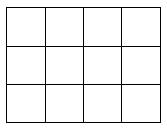 figure 3.10-a: Tessellation of the Euclidean plane |
 figure 3.10-b: Gaps are unavoidable when trying to tessellate the Euclidean plane with circles. |
The Dutch artist, M.C. Escher [1902-1972], created many beautiful tessellations. Figure 3.10-c is a low resolution copy of Escher's woodcut titled "Geckos" which is a tessellation of the Euclidean Plane. Escher also worked extensively with non-Euclidean geometries. In particular, his "Circle Limit" series are all tessellations of the Hyperbolic plane. Figure 3.10-d, titled "Heaven and Hell" is one of the works of the "Circle Limit" series. The demons and angles are each inscribed in congruent Hyperbolic triangles. The full size print is quite attractive.
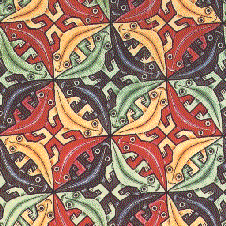 figure 3.10-c: Tessellation of the Euclidean plane by M.C. Escher |
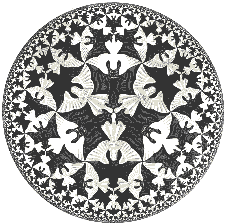 figure 3.10-d: Tessellation of the Hyperbolic plane by M.C. Escher |
Activity 3.10-1: Use NonEuclid to create your own tessellate the Hyperbolic plane using congruent Hyperbolic triangles. Print the tessellation and color it - inscribing some figure or pattern of figures in each triangle. The triangles used by Escher in "Heaven and Hell" are equilateral (thus it is a regular tessellation). Can the hyperbolic plane be tiled with other types triangles? Can it be tiled with any set of congruent triangles?
![]() NonEuclid Home
NonEuclid Home
![]() Next Topic - 4: The Shape of Space
Next Topic - 4: The Shape of Space